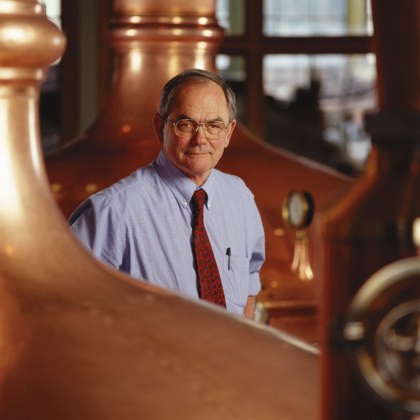To those of us in the rest of the country, “ the West Coast” is a world apart. Despite the vast geographical spread from California to Alaska, despite a cultural spread that brought us both the Grateful Dead and Ronald Reagan, viewed from the outside, the West is one strange singularity. It is Hollywood glitz, Haight Ashbury, Microsoft, and the ANWAR; the acceptable face of hedonism and the last outpost of the renegade.
Fritz, the scion of the Maytag washing machine family, was by his nature positively Jeffersonian in his eclectic pursuit of quality and substance.

Fritz Maytag of Anchor Brewing Co.
The restless people who kept moving west and further west had to stop here or step into the ocean: maybe all that restlessness got channeled into innovation?
Viewed from afar, West Coast-style brewing is a phenomenon: audacious, ground-breaking, and hop-heavy. There are communities “ out West” where craft beer outsells the Big Three, where it must be as daunting to open a new brewery as it is to open a new restaurant in New York.
The hard brewing facts support the sense that this is special territory: the four American states and one Canadian province that make up the West Coast of the United States and Canada contain over 30 million people, about 15% of the total. However, they are home to over 440 breweries, microbreweries and brewpubs: about 25% of the total.
The western states and British Columbia gave their countries their first brewpubs and they take home a disproportionate share of national brewing awards. In short, things are happening there.
For 15 years, Celebrator Beer News has been the voice of West Coast beer. We asked Tom Dalldorf, Celebrator’s publisher, to help us make sense of it all.
—AAB
A Stanford University graduate student in Japanese studies had only lunch and a cold beer on his mind that fateful afternoon in July 1965. But when Fritz Maytag ordered his usual Steam Beer, the server suggested that he savor it because the brewery was to be closed.
Fritz, the scion of the Maytag washing machine family, was by his nature positively Jeffersonian in his eclectic pursuit of quality and substance in everything he found worthy. He saw in that quirky beer brewed under primitive conditions something that was distinctly San Francisco and he had to learn more. Thus began an almost single-minded dedication to reviving lost traditions of brewing that is the hallmark of the Anchor Brewing Co.
Fritz dropped by the brewery and discovered that it was indeed to be closed after so many years, having survived even the devastating consequences of Prohibition. He wondered what he could do to help out. With a small investment and a lot of hard work, Fritz became the proud owner of a historic brewing property with rather poor prospects. Even with the San Francisco Chronicle’s Fearless Spectator Charles McCabe singing its praises, Anchor’s Steam Beer was a bastard child of the beer business and an unruly one at that. Fritz set to work cleaning up the brewery and stabilizing the beer.
Eventually, Maytag discovered the adage to be true in beer as it is in wine: the way to make a small fortune is to start with a really big one. This expensive avocation could not continue for long. A new location and some more modern equipment and quality control improved his product to the point where Maytag could actually sleep at night without worrying about the beer going bad.
Anchor produced fewer than 800 barrels of Steam the first year, but demand increased after the quality issues were addressed. Maytag’s research and travels to England and Europe convinced him that other styles might be equally attractive to a country notably devoid of beers of color or flavor. He introduced Liberty Ale in April 1975 to commemorate the midnight ride of Paul Revere, and the beer became so popular that he had to make it a year-round brand. Old Foghorn, a traditional English-style barley wine, was introduced that same year—another first. This was Anchor’s most extreme beer yet. Given its high alcohol and robust flavor profile, it must have been quite a radical move in a beer market awash in an ocean of light industrial adjunct lager.










